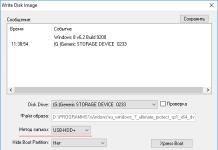What does a scanned mirror look like? CHIP has compiled for you a brief and visual information on the issue, so that at three in the morning you will read it and finally go to sleep with satisfaction.
So what will happen anyway?
Putting a mirror on the scanner and running the scan, the output will be a black mirror. Sounds weird, but looks weird.
Actually, the result will look something like this:
Round mirror scanned with a Canon scanner
As we can see, the final picture, to put it mildly, is not very similar to a mirror. Why is this happening? In order to understand this, let's first find out how the scanner works.
Modern scanners use many different technologies, but they are built, by and large, according to the same design principle, which is shown in the picture below.
Here is how the scanner is roughly arranged from the inside:
 Scanner Device Diagram
Scanner Device Diagram There is also an option with three mirrors:
 Scanner with three mirrors
Scanner with three mirrors The number of mirrors is not particularly important to us, since scanning is performed according to the same general principle.
How is scanning done?
Using the first diagram from the previous section (two-mirror scanner), let's see how a document is scanned. The stages of the process are indicated on the diagram by numbers in purple circles.
When we place a document on the scanner and start scanning, something like this happens:
- A moving light source (1) shines through the document through the glass substrate. In the process of highlighting, the source sequentially passes along the entire document.
- The illuminated document is reflected in a moving mirror (2) that follows the light source at the same speed.
- Reflection from a moving mirror is picked up by a fixed mirror (3) mounted on the opposite side of the scanner.
- The image from the fixed mirror is read by a charge-coupled device (CCD or CCD) and transmitted to a computer (4). This is how we get and save a scanned copy of the document.
 Charge-coupled device matrix - the most important microcircuit in the scanner
Charge-coupled device matrix - the most important microcircuit in the scanner What happens if you scan a mirror?
Now let's replace the paper document in our scheme with a mirror and try to scan it.
Here is what will start happening inside the scanner if you do this:
 Mirror scan
Mirror scan - In the mirror lying on the scanner will be reflected bottom of the scanner.
- The reflection of the lower part of the scanner body from the mirror will be highlighted and picked up by the moving mirror.
- Reflection from a moving mirror will be picked up by a fixed mirror.
- The CCD-matrix reads the image and transfers it to the computer.
Thus, by scanning the mirror, we get an image scanner bottom cover.
Depending on the color of the cover, the output image will be the same color, for example, blue, white, gray. In our example, we got a mysterious black mirror.
The scanner will also capture the shape of the mirror and possibly the scratches and dust on it. The result will be something like what we showed you at the beginning of the article.
Note from physicists
Modern scanners may also have optical focal elements that help to clearly capture the image of letters or lines on a sheet of paper.
Therefore, if you put a mirror on the scanner, the output image can also turn out to be quite blurry. This will happen because the focal optics will have nothing to focus on.
However, if there are scratches, dust particles, hairs on the mirror, the output will be a clear image of them against a blurred background of the color of the lower part of the scanner body.
What does a scanned mirror look like? CHIP has compiled for you a brief and visual information on the issue, so that at three in the morning you will read it and finally go to sleep with satisfaction.
So what will happen anyway?
Putting a mirror on the scanner and running the scan, the output will be a black mirror. Sounds weird, but looks weird.
Actually, the result will look something like this:
Round mirror scanned with a Canon scanner
As we can see, the final picture, to put it mildly, is not very similar to a mirror. Why is this happening? In order to understand this, let's first find out how the scanner works.
Modern scanners use many different technologies, but they are built, by and large, according to the same design principle, which is shown in the picture below.
Here is how the scanner is roughly arranged from the inside:
 Scanner Device Diagram
Scanner Device Diagram There is also an option with three mirrors:
 Scanner with three mirrors
Scanner with three mirrors The number of mirrors is not particularly important to us, since scanning is performed according to the same general principle.
How is scanning done?
Using the first diagram from the previous section (two-mirror scanner), let's see how a document is scanned. The stages of the process are indicated on the diagram by numbers in purple circles.
When we place a document on the scanner and start scanning, something like this happens:
- A moving light source (1) shines through the document through the glass substrate. In the process of highlighting, the source sequentially passes along the entire document.
- The illuminated document is reflected in a moving mirror (2) that follows the light source at the same speed.
- Reflection from a moving mirror is picked up by a fixed mirror (3) mounted on the opposite side of the scanner.
- The image from the fixed mirror is read by a charge-coupled device (CCD or CCD) and transmitted to a computer (4). This is how we get and save a scanned copy of the document.
 Charge-coupled device matrix - the most important microcircuit in the scanner
Charge-coupled device matrix - the most important microcircuit in the scanner What happens if you scan a mirror?
Now let's replace the paper document in our scheme with a mirror and try to scan it.
Here is what will start happening inside the scanner if you do this:
 Mirror scan
Mirror scan - In the mirror lying on the scanner will be reflected bottom of the scanner.
- The reflection of the lower part of the scanner body from the mirror will be highlighted and picked up by the moving mirror.
- Reflection from a moving mirror will be picked up by a fixed mirror.
- The CCD-matrix reads the image and transfers it to the computer.
Thus, by scanning the mirror, we get an image scanner bottom cover.
Depending on the color of the cover, the output image will be the same color, for example, blue, white, gray. In our example, we got a mysterious black mirror.
The scanner will also capture the shape of the mirror and possibly the scratches and dust on it. The result will be something like what we showed you at the beginning of the article.
Note from physicists
Modern scanners may also have optical focal elements that help to clearly capture the image of letters or lines on a sheet of paper.
Therefore, if you put a mirror on the scanner, the output image can also turn out to be quite blurry. This will happen because the focal optics will have nothing to focus on.
However, if there are scratches, dust particles, hairs on the mirror, the output will be a clear image of them against a blurred background of the color of the lower part of the scanner body.
Photo: Shutterstock.com / Glovatskiy
Curious Internet users are wondering: "What happens if you scan the mirror"? Getting the answer is quite simple if you do the experiment yourself. It does not require any effort and does not take much time. It is not difficult to find a mirror; many people have a scanner at home or at work. But not everyone decides to find the answer to this unusual question empirically - there is a version that as a result of scanning the mirror, the device may fail.
What other versions are there?
There are at least three more, at first glance, plausible versions of what can be obtained as a result of mirror scanning:
1. image of the internal parts of the scanner, for example, carriages and lamps, which will be reflected by the mirror;
2. a light spot, which is formed due to the reflection of the glow of the scanner lamp;
3. dark spot.
And what actually happens?
In fact, if you scan a mirror, its image on a computer or on a sheet of paper will be represented by a black spot. If there were scratches on the mirror, light lines or spots will correspond to them in the scanned image.
Why is this happening?
This is due to the principle of the scanner. During scanning, a carriage with a lamp moves along the working area, which illuminates the object. The reflected rays of light are recorded by a special device - their pixel value is transmitted to the computer. The more light is reflected (and a lot of it is when scanning a mirror), the brighter the scanned areas are.
Many people who came across this question were very interested in it. After all, it is not known what can happen in this case. Some believe that in this case the scanning device will be reflected, and on the monitor display, or on a sheet of paper, we will see the scanning head. In addition, due to the fact that the scanning device works in conjunction with a white lamp, there was an opinion about an empty, white scan result.
Other guesses for the result:
- a scanning device with a lamp will be visible;
- you get a photograph consisting of stripes that differ little in color from each other, with the naked eye you can see only a white spot with barely noticeable blurry spots. According to supporters of this hypothesis, this is because the optical device will scan itself, illuminated by a laser;
- you can see people who used this mirror, or creatures in the other world;
- the scanner will fail if the mirror is scanned;
- you can see the looking glass.
To finally figure out what will happen, you need to conduct a small experiment. It will take a short period of time, no effort is needed, and the scanner will definitely not fail.

You need to take any mirror, for maximum effect it is desirable to use an A4 format mirror, without rims and frames, but this is not necessary. It is necessary to place it with the reflecting side to the scanning device. That's all, it remains only to turn on the device and start the scanning process.
Scan results.
In the course of the experiment, it turned out that the result of scanning the mirror would be a black sheet. If the mirror was not perfectly clean and it has mounts, then light spots will be slightly visible in the resulting image in these places. This is due to the fact that in addition to the scanning device on the carriage there is a lamp that illuminates the image. As the carriage moves along the image, the reflective beams are received by the CCD scanning head, which converts the light into an electrical current. The brighter the light, the more current flows into the processor, which, in turn, supplies a larger value to the pixel, corresponding to more illumination.
In the absence of the opportunity to conduct this experiment on your own, you can use the Internet and see a lot of videos that clearly show the result.
Video: What happens if you scan a mirror?
Since ancient times, when the first mirrors had just appeared and until today, they are credited with a mystical influence on the life and destiny of people. You can read about the magical properties of mirrors in many fairy tales. In the article, we will understand the question of why it is impossible to scan a mirror.
And today, some people believe that the mirror stores all the information about those personalities and events that have ever been reflected on its surface. Mirrors are credited with the ability to show both the past and the future.
- There is also a belief that looking in the mirror for a long time, you can get into the other world - through the looking glass, and communicate with long-dead relatives.
- For many centuries, mirrors have been used by psychics and magicians for various rituals. They are a necessary item for those who believe in the existence of ghosts, the other world, and are trying to establish contact with them.
- And Christmas maiden divination without a mirror is even hard to imagine. Two mirrors set opposite each other, a mirror corridor appeared - and now it is already seen how the betrothed is walking along it towards the future bride.
Why you can't scan the mirror
In many families, it is considered obligatory to hang mirrors with a cloth if there is a deceased in the house. So that his soul is not stuck between two worlds, the reflection of the deceased should not appear in the mirror DURING THE FUNERAL.
Bioenergetics, for their part, warn people about the dangers of buying antique or used mirrors. They believe that the negative information received by the mirror from the previous owners can adversely affect the health and even the fate of those who bought the antique mirror.
When the first scanners appeared, there was even a scientific theory about scanning mirrors in order to obtain certain information. Scientists believed that the reflections accumulated on the surface of the mirror could be turned into photographs using computer technology and a scanner.
Most likely, it is these mysterious properties attributed to mirrors that make many curious people wonder - what will happen if a mirror is scanned?
Is it possible, with the help of scanning, to see on paper the reflections of the former owners of the mirror, the souls of long-dead relatives? Wouldn't the resulting image be as dangerous as the "worn out" mirror itself? All these mysterious questions, doubts, possible dangers further fuel the desire to find out if it is possible or not to scan the mirror?
What happens if you scan a mirror?
Everyone knows that the forbidden, and even the mysterious fruit is sweet. Surely, many, reading this article, have already had a desire to conduct an experiment - SCAN THE MIRROR. Nothing special is needed for this - just a sheet of white paper, a scanner and a mirror that will fit under its cover.
We press the button and at the output we get a black spot on a white sheet, which is equal to the shape of a mirror. Of course, we will not have images of people and events witnessed by this mirror. Moreover, there will be no photographs of creatures from the other world. Even the insides of the scanner (the lamp with the carriage), which could be reflected in the mirror, will not be printed on the sheet.
Scientists have long proven that during scanning, a flash occurs when exposed to light. The shape of the flash will be equal to the size of the mirror. There may be light spots against the black image of the mirror if the mirror has been dirty or scratched.
Why not? Can! The scanner will not be damaged if everything is done carefully. Is it just necessary? Nothing interesting or mysterious will happen if you scan the mirror. You will not discover any unknown secrets, and you will not wait for meetings with creatures from the other world.


























